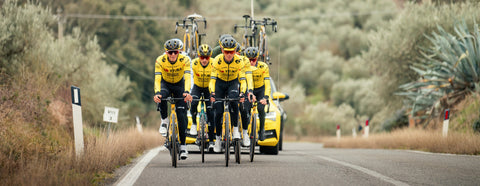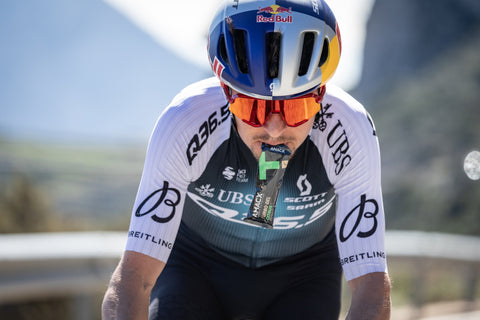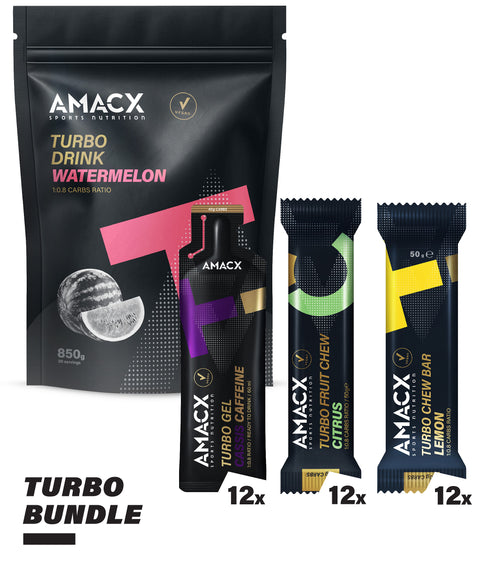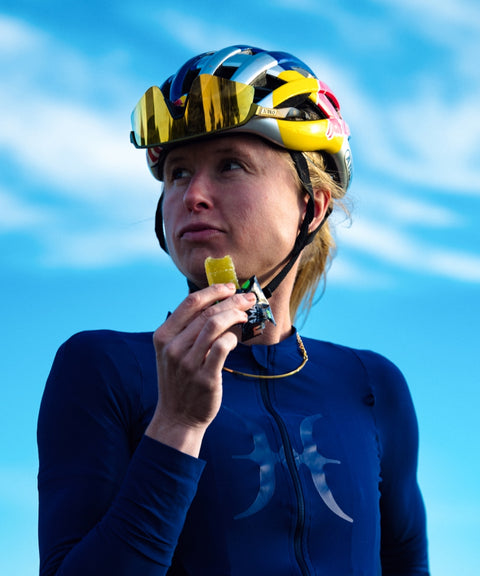In an earlier blog you could read what an indispensable role the correct carbohydrate intake plays during your endurance exercise. It also emerged that with higher carbohydrate intakes, the ratio between glucose and fructose plays an important role in absorption into the body. But which ratio is best and when? Are Turbo products with a 1:0.8 ratio by definition better than Energy products with a 2:1 ratio? And what is the difference between a 1:0.8 and 1:1 ratio of glucose to fructose? You will find answers to all these questions in this blog.
In summary
- To provide more than 60 grams of carbohydrates per hour to the muscle, a mix of glucose and fructose must be taken. This ensures that multiple absorption transporters in the intestine are used.
- Up to intakes of ± 90 grams per hour, products with a 2:1 ratio between glucose and fructose offer the best balance between carbohydrate availability in the muscle, taste and stomach/intestinal comfort.
- Intakes above 90 grams per hour can provide even more fuel to the muscle. A 1:0.8 ratio between glucose and fructose is the most ideal for this. This results in improved performance and recovery during extreme efforts.
- Stomach/intestinal training with the right products is always necessary to be able to use this in the most important competitions without complaints.
The fundamental role of carbohydrates in sports performance
It should no longer be a secret that carbohydrates are the most important source of energy for top performance in sports. The first studies already showed this in the 1920s. Particularly since the 1960s, knowledge about the importance of carbohydrates has increased, especially about the role of muscle glycogen in endurance sports.1 For example, it was shown that endurance performance improved significantly when sufficient carbohydrates were available in the body, and that fatigue and exhaustion could be significantly delayed if endurance athletes consumed carbohydrates during exercise.2
From maltodextrin to glucose mix
For a long time, no distinction was made between the type of carbohydrate. Many studies at that time only used maltodextrin: a chain of glucose molecules that forms the most quickly absorbed sugar. In the late 1990s, researchers found that the muscles could use no more than ± 60 grams of carbohydrates per hour as fuel. Not even if the intake was (much) higher than that. Despite the lack of direct evidence for this, this led to the idea that the absorption capacity in the intestines was a limiting factor. Especially when it turned out that adding other forms of glucose led to higher carbohydrate consumption in the muscle.3 Until 2007, the advice for endurance athletes was to consume a maximum of 60 grams of carbohydrates per hour.

The optimal mix of glucose and fructose
Because glucose is absorbed by the body in the intestine via the sodium-dependent glucose transporter (SGLT1), the researchers looked for carbohydrates that are absorbed into the body via a different route. Fructose was the most interesting, because its absorption occurs via the GLUT-5 transporter. This means that the absorption of glucose and fructose can occur simultaneously and independently of each other. It was soon shown that a mix of glucose and fructose indeed led to a significantly higher carbohydrate consumption in the muscles.4 The search for the most ideal ratio between the two carbohydrates had officially started.
The studies that followed shortly afterward soon came to the consensus that endurance athletes could increase their carbohydrate intake per hour by up to 90 grams per hour if the effort lasted longer than 2.5 hours. A 2:1 ratio between glucose and fructose emerged as an ideal balance between a higher carbohydrate supply for the muscle and a pleasant taste at the same time. Fructose is very sweet, so as soon as it was added in too large an amount, the products were sometimes perceived as too sweet and sticky.5 Since then, an intake of 90 grams per hour via a 2:1 ratio has become a standard guideline, and you see this ratio in many contemporary sports nutrition products. It still applies that if you aim for an intake of up to 90 grams per hour, this 2:1 ratio offers the best balance between fuel supply and good taste
The power of a 1:0.8 glucose-fructose mix
However, a more recent, more detailed look at studies from the early years of this century showed that adding more fructose could lead to even higher carbohydrate utilization in the muscle. This could yield performance gains, especially during the most extreme endurance efforts.5 A renewed analysis of glucose:fructose ratios between 1:0.7 and 1:1 showed that the ratio 1:0.8 resulted in the highest carbohydrate consumption in the muscle and should lead to the greatest performance improvement in extreme endurance efforts.6 Moreover, no problems with taste and/or gastrointestinal complaints were reported.

A 2011 study confirmed this for the first time: this research showed that an intake of 110 grams of carbohydrates per hour in a 1:0.8 ratio led to a higher use in the muscle than with the same intake in a 2 :1 ratio. Moreover, the endurance performance of the first group was better than that of the second group.6 Meanwhile, several studies have confirmed that intakes of up to 120 grams per hour in a 1:0.8 ratio indeed lead to the highest carbohydrate availability in the muscle, a beneficial effect on recovery around efforts of extreme duration and/or intensity and also appear to lead to better performance.7-12 For this reason, products with this composition are the best choice for athletes if they aim for intakes of 90 to 120 grams per hour during extreme efforts.
As described in previous blogs, training your stomach and intestines is still crucial to tolerate these extremely large carbohydrate intakes during a heavy training or competition. Therefore, in addition to selecting the right products, do not forget to train very regularly and gradually increase the total amount of carbohydrates per hour.

References
-
Bergstrom J, Hermansen L, Hultman E, and Saltin B. Diet, muscle glycogen and physical performance. Acta Physiol Scand 71: 140-150, 1967.
-
Hawley JA, Schabort EJ, Noakes TD, and Dennis SC. Carbohydrate-loading and exercise performance. An update. Sports Med 24: 73-81, 1997.
-
Jentjes RLPG, Moseley Lm Waring RH, Harding LK, Jeukendrup AE. Oxidation of combined ingestion of glucose and fructose during exercise. J Appl Physiol 96(4): 1277-87, 2004.
-
Jeukendrup AE. Carbohydrate and exercise performance: the role of multiple transportable carbohydrates. Curr Opin Clin Nutr Metab Care 13(3): 352-7, 2010.
-
Podlogar T, Wallis GA. New Horizons in Carbohydrate Research and Application for Endurance Athletes. Sports Med 52: 5-23, 2022
-
O’Brien WJ, Rowlands DS. Fructose-maltodextrin ratio in a carbohydrate-electrolyte solution differentially affects exogenous carbohydrate oxidation rate, gut comfort, and performance. Am J Physiol Gastrointest Liver Physiol 300(1): 181-9, 2011.
-
Rowlands DS, Houltham S, Musa-Veloso K, Brown F, Paulionis L, Bailey D. Fructose-Glucose Composite Carbohydrates and Endurance Performance: Critical Review and Future Perspectives. Sports Med 45(11): 1561-76, 2015.
-
Urdampilleta A, Arribalzaga S, Viribay A, Castañeda-Babarro A, Seco-Calvo J, Mielgo-Ayuso J. Effects of 120 vs. 60 and 90 g/h Carbohydrate Intake during a Trail Marathon on Neuromuscular Function and High Intensity Run Capacity Recovery. Nutrients 12(7): 2094, 2020
-
Viribay A, Arribalzaga S, Mielgo-Ayuso J, Castañeda-Babarro A, Seco-Calvo J, Urdampilleta A. Effects of 120 g/h of Carbohydrates Intake during a Mountain Marathon on Exercise-Induced Muscle Damage in Elite Runners. Nutrients 12(5): 1367, 2020.
-
Cox GR, Snow RJ, Burke LM. Race-day carbohydrate intakes of elite triathletes contesting olympic-distance triathlon events. Int J Sport Nutr Exerc Metab 20(4): 299-306, 2010.
-
Hearris MA, Pugh JN, Langan-Evans C, Mann SJ, Burke LM, Stellingwerff T, Gonzalez JT, Morton J. 13C-glucose-fructose labelling reveals comparable exogenous CHO oxidation during exercise when consuming 120 g/h in fluid, gel, jelly chew or co-ingestion. J Appl Physiol 132(6): 1394-1406, 2022
-
Podlogar T, Bokal S, Wallis GA. Increased exogenous but unaltered endogenous carbohydrate oxidation with combined fructose-maltodextrin ingested at 120 g h−1 versus 90 g h−1 at different ratios. Eur J Appl Physiol, 122(11): 2393-2401, 2022.












